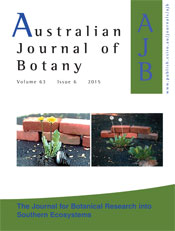Australian Journal of Botany
Volume 63
Number 6 2015
Population genetics and evolutionary histories of threatened plants need to be understood to establish effective conservation strategies. We studied the genetic patterns of Fritillaria walujewii and found that Xinyuan County is the centre of diversification, and that populations in the eastern Tianshan Mountains were colonised from the Yili Valley. This information will provide prudent management strategies for its recovery.
A better understanding of the reproductive ecology of invasive species can assist land managers in developing effective control strategies. In its invaded range Salix cinerea was found to be ambophilous with both insects and wind playing a role in pollination while initial germination was found to be high but seed were short-lived. These results show a limited seed bank is available for this species highlighting that reducing seed set and dispersal should reduce reinfestation.
We sought to understand and contrast the ecology of two endemic species of Beyeria (plant family Euphorbiaceae) from southern Western Australia. Unexpectedly, the more common and widespread Beyeria villosa appeared to have lower reproductive fitness than the very restricted B. cockertonii. However, B. cockertonii appeared dependent on a specific insect pollinator and this, along with habitat specificity, may render it vulnerable to threatening processes. The study will inform the conservation management of these species that are threatened by mining activities.
Perennial geophytes such as Chamaescilla corymbosa are key components of shallow, nutrient-impoverished soils on granite outcrops in south-western Australia. Here, geophytes aestivate in response to severe drought and heat in summer, alternating with growth and flowering during wet and cool winter and spring seasons. Our investigation used a multi-faceted approach. The results clearly showed that growth and survival of C. corymbosa depends on a range of physiological, chemical and structural traits that have implications for addressing broader questions of diversity and adaptation in other long-lived species from similar Mediterranean-climate rock-outcrop environments.
Dandelion plants (Taraxacum officinalae) can lift an overhead weight of 2–3 N, sustaining this force for 3–4 weeks, causing yielding and cracking of an 8 cm thick macadam surface. Euler buckling theory was applied to experiments on flower stems and leaf stalks, estimating stresses, strains and modulus of the plant-tube wall, under heavy loading from overhead weight.
The sedge Baumea juncea has a disjunct distribution in South Australia, occurring in coastal regions and also on scattered artesian springs in inland arid regions. We found that the growth responses of plants to salinity and waterlogging treatments differed depending on the region from which the plants originated.
The distribution and extent of P. spinescens floodplain grasslands at Barmah Forest was uncertain, despite its internationally recognised ecological importance. During repeated on-ground surveys over 2 successive years, we mapped ~182 ha of P. spinescens, which covered only a small fraction of the treeless lakes and plains. These findings demonstrate the importance of accurately quantifying the distribution of species of high conservation significance and developing an understanding of the drivers of their decline.
Mistletoes uptake nutrients and water from their hosts. It was observed that parasitic plants do not randomly infect the host, and heavily infected tress grow nearby uninfected ones. We studied if the genetic makeup of Nothofagus antarctica determine infection patterns by the mistletoe Misodendrum in temperate South America. Genetic characteristics differed between infected and non-infected trees which suggest parasites as selective agents on individual trees.




